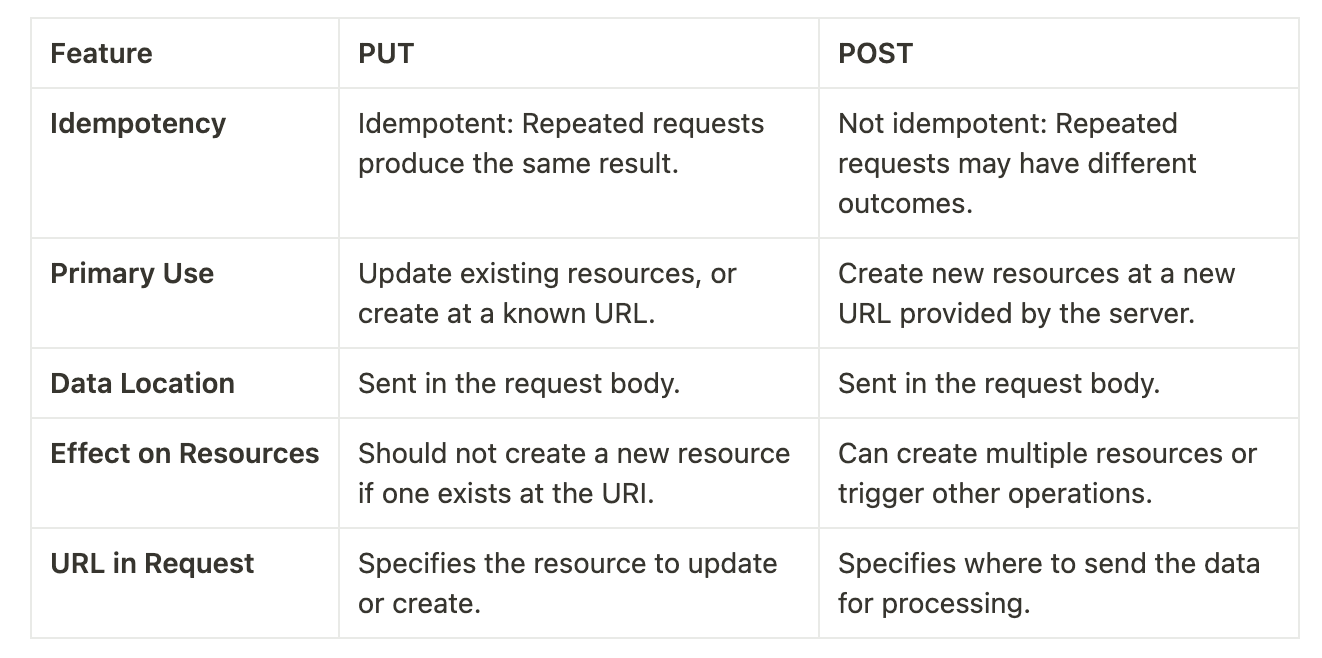PUT vs POST

Luke Stephens
Nov 3, 2023
PUT vs POST
PUT and POST are two HTTP methods often used in API and web form communication. They have distinct roles. The key differences between PUT and POST HTTP methods are as follows:
Idempotency
PUTis idempotent, meaning that making the same request will always produce the same result.In contrast,
POSTis not idempotent, so repeated requests may yield different outcomes.
Primary Use
PUTis typically used to update existing resources, or to create new resources at a specified, known URL.On the other hand,
POSTis mainly used to create new resources, with the server providing the new URL.
Data Location
Both
PUTandPOSTsend data in the request body.
Effect on Resources
PUTshould not create a new resource if one already exists at the given URI.Conversely,
POSTcan create multiple resources or trigger a variety of other operations.
URL in Request
In a
PUTrequest, the URL specifies the resource to be updated or created.For
POSTrequests, the URL indicates where to send the data for processing.
Example of Http PUT vs POST:
A real-world analogy for PUT vs POST is the difference between placing a letter in a specific mailbox (PUT) versus dropping it into a post box (POST).
For PUT, imagine you have a letter to send to a specific person at a known address. You go directly to their mailbox (the URI) and place the letter inside. If a letter from you is already in the mailbox, it gets replaced with the new one. This is similar to how PUT works: you are placing data at a known URI, and if data already exists there, it gets replaced with the new data.
For POST, imagine you have a letter but no specific mailbox to place it in. Instead, you drop it into a post box. The postal service (the server) then decides where the letter needs to go based on the information you've provided. If you drop multiple letters into the post box, multiple deliveries will be made. Similarly, with POST, you send data to a server that determines where the data should be stored, and multiple POST requests can result in multiple new resources.

PUT to update a resource:
POST to create a resource:
How to Choose between PUT and POST
Use PUT when:
The client is responsible for determining the URI of the new or updated resource.
You are replacing an entire resource or creating a resource with a client-defined identifier.
The operation needs to be idempotent, ensuring that repeated requests will have the same effect as a single request.
Use POST when:
The server is responsible for assigning a new unique identifier for the created resource.
The operation does not have to be idempotent, or it involves creating new resources.
The action performed is complex or does not fit neatly into the CRUD model.
PUT is ideal when the client knows the exact location of the resource and wants to update it or create a new resource at that location. POST is better suited for when the client is submitting data to be processed by the server, and the server will determine where the new resource will be located (specifying the new URL in its response).
Explore more from Akto
Blog
Be updated about everything related to API Security, new API vulnerabilities, industry news and product updates.
Events
Browse and register for upcoming sessions or catch up on what you missed with exclusive recordings
CVE Database
Find out everything about latest API CVE in popular products
Test Library
Discover and find tests from Akto's 100+ API Security test library. Choose your template or add a new template to start your API Security testing.
Documentation
Check out Akto's product documentation for all information related to features and how to use them.

